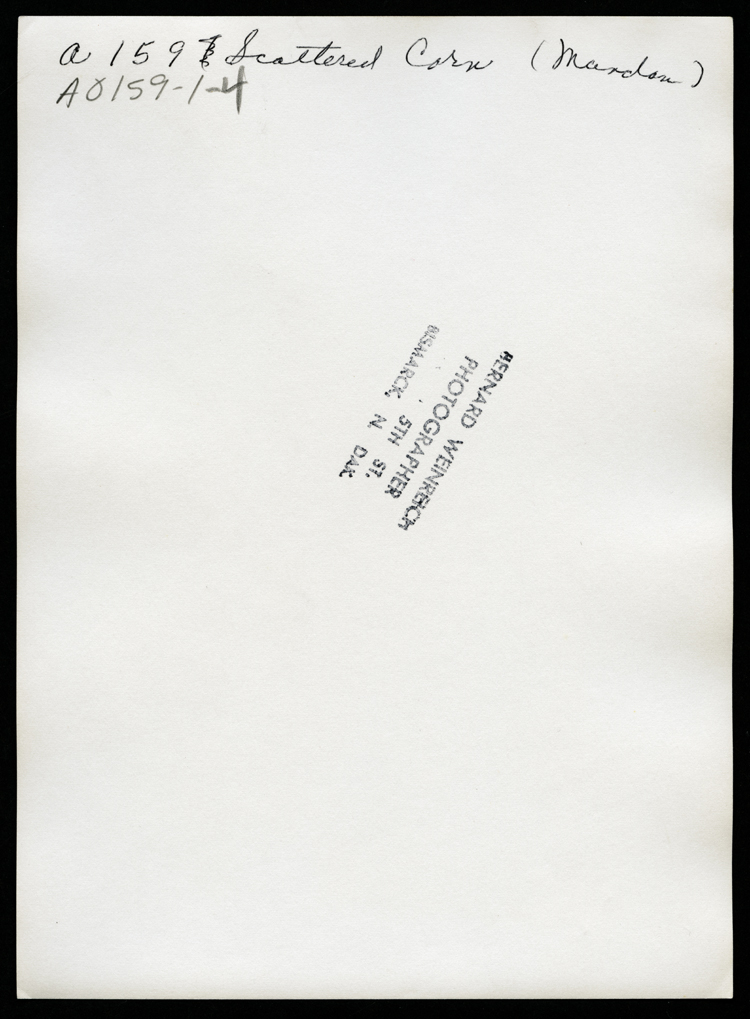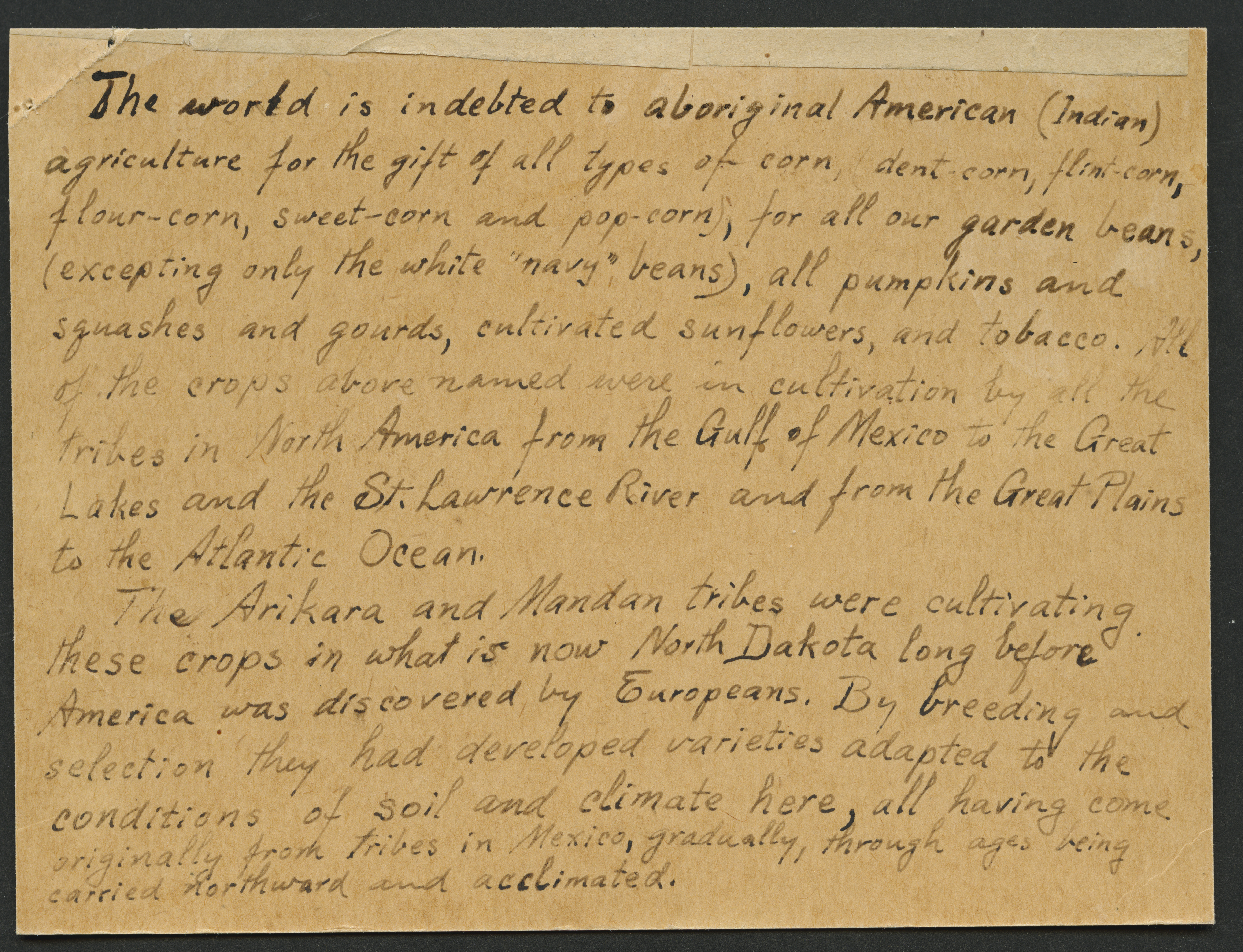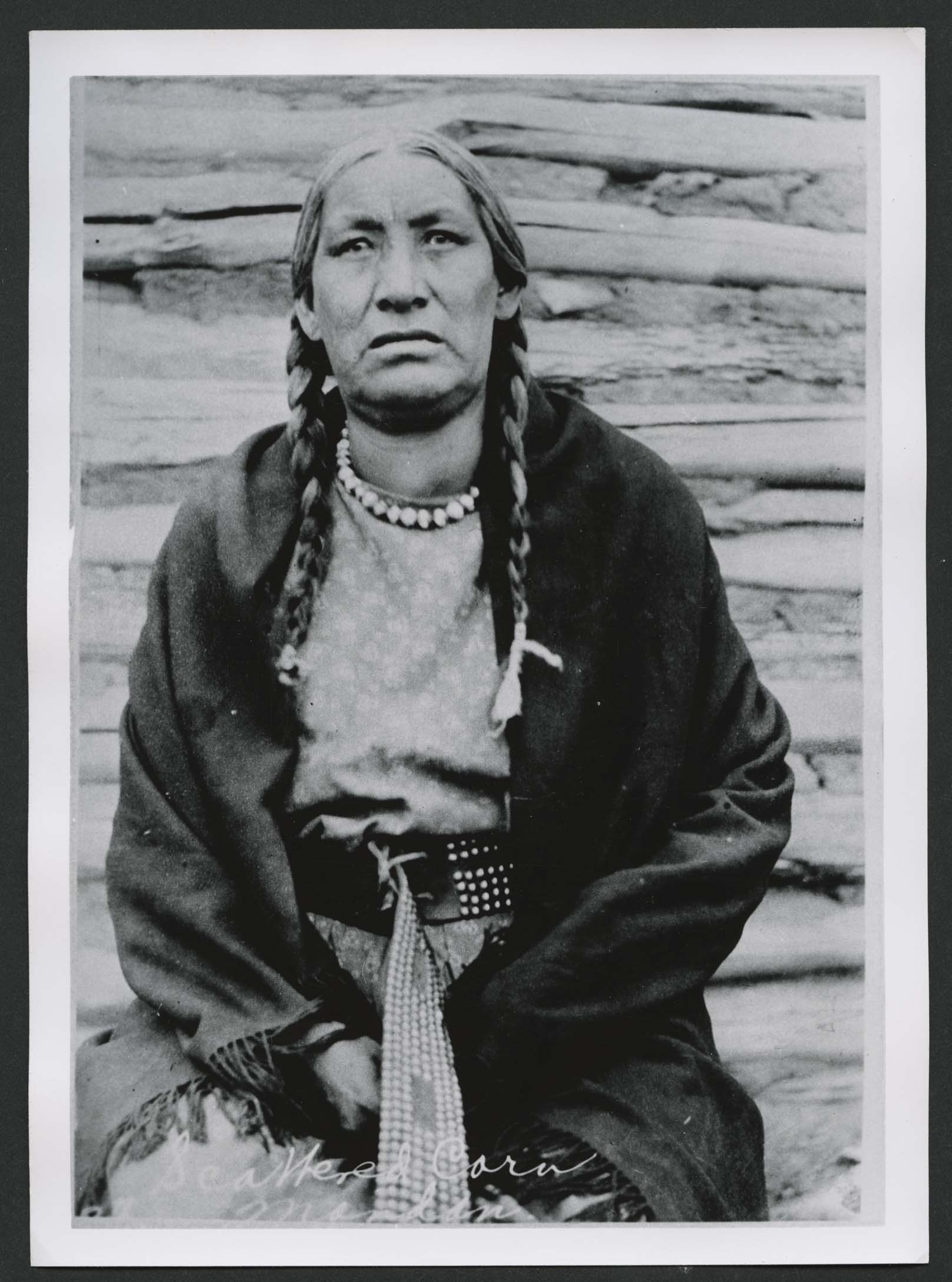Collection: A - A Collection
Folder: 0000.000
Item: 0159_00001
Title: Scattered Corn, Mandan Indian
Date: ca. 1920
Creator: Weinreich, Bernard E.,--1917-2000
Inscription/Marks: "Scattered Corn Mandan"-- handwritten on back --"Bernard Weinreich Photographer 5th St. Bismarck, N. Dak."-- stamped on back --"The world is indebted to aboriginal American (Indian) agriculture for the gift of all types of corn, (dent-corn, flint-corn, flour-corn, sweet-corn and pop-corn), for all our garden beans, (excepting only the white "navy" beans), all pumpkins and squashes and gourds, cultivated sunflowers, and tobacco. All of the crops above named were in cultivation by all the tribes in North America from the Gulf of Mexico to the Great Lakes and the St. Lawrence River and from the Great Plains to the Atlantic Ocean.
The Arikara and Mandan tribes were cultivating these crops in what is now North Dakota long before America was discovered by Europeans. By breeding and selection they had developed varieties adapted to the conditions of soil and climate here, all having come originally from tribes in Mexico, gradually, through ages being carried northward and acclimated."-- handwritten on a separate piece of cardboard
Summary: Seated three-quarter length outdoor portrait of Scattered Corn with long braids tied at end with cloth. She is wearing a patterned dress with leather belt with metal tacks tied with leather strings. A dark coloured blanket with fringes covers her shoulders and her arms. Behind her is a log building.
There is a seperate piece of paper with the photo that reads, " The world is indebted to aboriginal American (Indian) agriculture for the gift of all types of corn, dent-corn, flint-corn, flour-corn, sweet-corn and pop-corn, for all our garden beans, (excepting only the white "navy" beans), all pumpkins and squashes and gourds, cultivated sunflowers, and tobacco. All of the crops above named were in cultivation by all the tribes in North America from the Gulf of Mexico to the Great Lakes and the St. Lawrence River and from the Great Plains to the Atlantic Ocean. The Arikara and Mandan tribes were cultivating these crops in what is now North Dakota long before America was discovered by Europeans. By breeding and selection they had developed varieties adapted to the conditions of soil and climate here, all having come originally from tribes in Mexico, gradually, through ages being carried northward and acclimated.
Red ID: PH_I_94175 Image ID: 36047 Image Notes: A0159-00001-4-back
Collection: A - A Collection
Folder: 0000.000
Item: 0159_00001
Title: Scattered Corn, Mandan Indian
Date: ca. 1920
Creator: Weinreich, Bernard E.,--1917-2000
Inscription/Marks: "Scattered Corn Mandan"-- handwritten on back --"Bernard Weinreich Photographer 5th St. Bismarck, N. Dak."-- stamped on back --"The world is indebted to aboriginal American (Indian) agriculture for the gift of all types of corn, (dent-corn, flint-corn, flour-corn, sweet-corn and pop-corn), for all our garden beans, (excepting only the white "navy" beans), all pumpkins and squashes and gourds, cultivated sunflowers, and tobacco. All of the crops above named were in cultivation by all the tribes in North America from the Gulf of Mexico to the Great Lakes and the St. Lawrence River and from the Great Plains to the Atlantic Ocean.
The Arikara and Mandan tribes were cultivating these crops in what is now North Dakota long before America was discovered by Europeans. By breeding and selection they had developed varieties adapted to the conditions of soil and climate here, all having come originally from tribes in Mexico, gradually, through ages being carried northward and acclimated."-- handwritten on a separate piece of cardboard
Summary: Seated three-quarter length outdoor portrait of Scattered Corn with long braids tied at end with cloth. She is wearing a patterned dress with leather belt with metal tacks tied with leather strings. A dark coloured blanket with fringes covers her shoulders and her arms. Behind her is a log building.
There is a seperate piece of paper with the photo that reads, " The world is indebted to aboriginal American (Indian) agriculture for the gift of all types of corn, dent-corn, flint-corn, flour-corn, sweet-corn and pop-corn, for all our garden beans, (excepting only the white "navy" beans), all pumpkins and squashes and gourds, cultivated sunflowers, and tobacco. All of the crops above named were in cultivation by all the tribes in North America from the Gulf of Mexico to the Great Lakes and the St. Lawrence River and from the Great Plains to the Atlantic Ocean. The Arikara and Mandan tribes were cultivating these crops in what is now North Dakota long before America was discovered by Europeans. By breeding and selection they had developed varieties adapted to the conditions of soil and climate here, all having come originally from tribes in Mexico, gradually, through ages being carried northward and acclimated.
Red ID: PH_I_94175 Image ID: 58346 Image Notes: A0159-00001-id
Collection: A - A Collection
Folder: 0000.000
Item: 0159_00001
Title: Scattered Corn, Mandan Indian
Date: ca. 1920
Creator: Weinreich, Bernard E.,--1917-2000
Inscription/Marks: "Scattered Corn Mandan"-- handwritten on back --"Bernard Weinreich Photographer 5th St. Bismarck, N. Dak."-- stamped on back --"The world is indebted to aboriginal American (Indian) agriculture for the gift of all types of corn, (dent-corn, flint-corn, flour-corn, sweet-corn and pop-corn), for all our garden beans, (excepting only the white "navy" beans), all pumpkins and squashes and gourds, cultivated sunflowers, and tobacco. All of the crops above named were in cultivation by all the tribes in North America from the Gulf of Mexico to the Great Lakes and the St. Lawrence River and from the Great Plains to the Atlantic Ocean.
The Arikara and Mandan tribes were cultivating these crops in what is now North Dakota long before America was discovered by Europeans. By breeding and selection they had developed varieties adapted to the conditions of soil and climate here, all having come originally from tribes in Mexico, gradually, through ages being carried northward and acclimated."-- handwritten on a separate piece of cardboard
Summary: Seated three-quarter length outdoor portrait of Scattered Corn with long braids tied at end with cloth. She is wearing a patterned dress with leather belt with metal tacks tied with leather strings. A dark coloured blanket with fringes covers her shoulders and her arms. Behind her is a log building.
There is a seperate piece of paper with the photo that reads, " The world is indebted to aboriginal American (Indian) agriculture for the gift of all types of corn, dent-corn, flint-corn, flour-corn, sweet-corn and pop-corn, for all our garden beans, (excepting only the white "navy" beans), all pumpkins and squashes and gourds, cultivated sunflowers, and tobacco. All of the crops above named were in cultivation by all the tribes in North America from the Gulf of Mexico to the Great Lakes and the St. Lawrence River and from the Great Plains to the Atlantic Ocean. The Arikara and Mandan tribes were cultivating these crops in what is now North Dakota long before America was discovered by Europeans. By breeding and selection they had developed varieties adapted to the conditions of soil and climate here, all having come originally from tribes in Mexico, gradually, through ages being carried northward and acclimated.
Red ID: PH_I_94175 Image ID: 36046 Image Notes: A0159-00001-4




